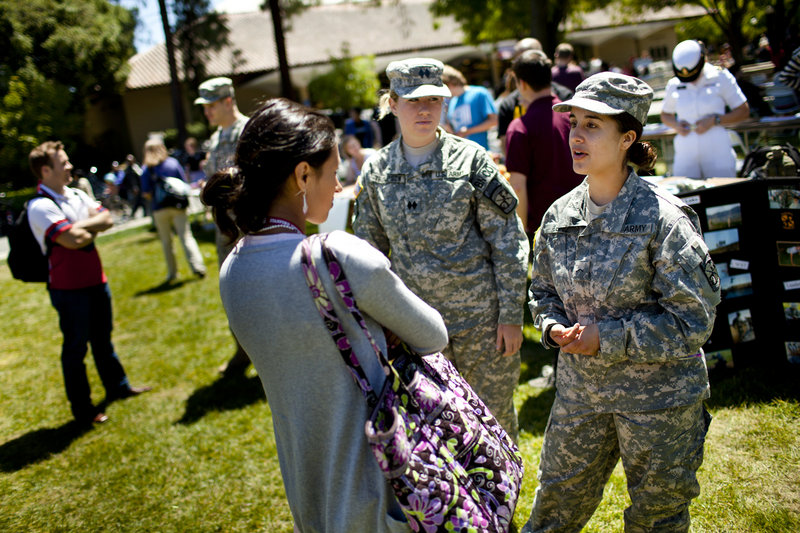PALO ALTO, Calif. – On an early May morning 43 years ago, fire swept through Stanford University’s Navy ROTC building, destroying a structure that had been damaged in another suspicious blaze just two months earlier.
No arrests were ever made in the two arson fires, but they came at a time of angry, sometimes violent demonstrations against the Vietnam War on college campuses nationwide. Those protests often targeted the closest symbol of the U.S. military, the Reserve Officers Training Corps — with more than 200 campus ROTC units reporting vandalism during that war.
Flash forward to a much different time.
On a recent afternoon, Stanford senior Ann Thompson wore her Army ROTC uniform with pride as she helped staff a recruiting table for the military training program at a campus activities fair. She chatted with visitors about the ROTC’s scholarships as a few dozen students marched nearby to protest the program’s likely expansion at Stanford.
“There definitely are people not supportive of ROTC, but we still have respectful conversations,” said Thompson, 22, of Paso Robles, Calif. “I can’t fathom anyone burning a building down.”
Helped by the recession, more active recruiting and a sea change in student perceptions of the military, enrollment in ROTC programs on college campuses is booming.
Even with ongoing U.S. involvement in conflicts in Afghanistan, Iraq and now Libya, participation in the program has surged 27 percent over the last four years — to 56,757 men and women, according to the Defense Department. The military boosted the number of ROTC scholarships to help expand the wartime officer corps, and the recession made the offers attractive to students.
Today’s college students, who never faced a military draft and whose childhood memories include the terrorist attacks of Sept. 11, 2001, are more receptive than their parents’ generation to seeing fellow students in uniform.
Returning veterans who served in Iraq and Afghanistan and are now enrolled in college also create a more sympathetic, and familiar, image of the military.
In another sign of the changing times, the congressional rescinding last year of the “don’t ask, don’t tell” ban on gays serving openly in the military has recently led Stanford, Harvard, Yale and several other elite universities to take steps to welcome the ROTC back to their campuses for the first time in 40 years.
Jimmy Ruck, a 21-year-old Stanford senior and Army ROTC cadet from Millbrae, Calif., will join a military intelligence unit as a second lieutenant after he graduates in the coming weeks.
“We are putting a face on the military, showing that we are not some faceless, heartless machine, that we are individual human beings and that we are doing this for a variety of reasons,” said Ruck, who along with Thompson is one of 14 Stanford students who are enrolled in the ROTC but must train at other Bay Area campuses. “Some are doing it for leadership, for public service, or if you want to pay for your college.”
Ruck applauded the April 28 Stanford faculty vote to invite the program back to the campus and said he hopes the university’s small ROTC contingent will grow, especially if its cadets no longer have to travel elsewhere to train.
Experts say the recent change of heart by influential American universities will boost the prestige of the program, which was founded during the Civil War on the belief that the nation needs a well-educated officer corps imbued with civilian values.
“It shows historically that the military and civilian society are trying to bridge the gap,” said Donald Downs, a political science professor at the University of Wisconsin-Madison and co-author of a new book about the ROTC.
In the Vietnam era, hostility toward the ROTC soared as the war’s casualties increased and reached a height when U.S. troops were sent into Cambodia in 1970. Student protesters occupied ROTC centers at many colleges, and fires and explosions damaged the program’s buildings at the University of Michigan, Kent State University and the University of Colorado.
The ROTC was pushed off some campuses after faculty and administrators stopped giving academic credit for its courses and imposed other restrictions. Programs elsewhere died for lack of interest after the draft ended in 1973 and fewer men sought to become officers as a way to survive the war.
From 1968 to 1974, the ROTC closed 88 units, many at private schools in the Northeast, and opened 80 replacements, mainly at friendlier public colleges in the South and Midwest, according to Michael Neiberg, a military historian at the University of Southern Mississippi who wrote a book about the program.
Nowadays, the Pentagon is happy to be wooed by Stanford and other top private schools. The Navy signed an agreement with Harvard in March and, last month, with Yale and Columbia to re-establish units.
“It’s just another thing that’s here, that’s available,” said Michelle McGrain, a student government leader at the University of Maryland. The student response “is kind of neutral,” she said. “It’s not a huge issue.”
Copy the Story Link
Send questions/comments to the editors.



Success. Please wait for the page to reload. If the page does not reload within 5 seconds, please refresh the page.
Enter your email and password to access comments.
Hi, to comment on stories you must . This profile is in addition to your subscription and website login.
Already have a commenting profile? .
Invalid username/password.
Please check your email to confirm and complete your registration.
Only subscribers are eligible to post comments. Please subscribe or login first for digital access. Here’s why.
Use the form below to reset your password. When you've submitted your account email, we will send an email with a reset code.